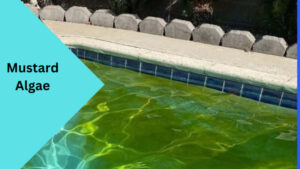Imagine diving into your sparkling pool, only to realize there’s an unwelcome visitor lurking beneath the surface. Mustard algae, a notorious pool contaminant, can quickly turn your pristine oasis into a less inviting space. In this blog post, we will explore the causes, prevention methods, and effective treatments to combat mustard algae and enjoy a clean and refreshing swimming experience. We will also provide a pool mustard algae Guide to help you identify this stubborn invader.
What is Mustard Algae?
Mustard algae, also known as yellow algae, is a common issue that plagues swimming pools, especially in warmer climates. This is a slimy, mustard-colored organism thrives in poorly maintained or untreated pools, and its presence can be quite frustrating for pool owners. Unlike typical green algae, mustard algae can be stubborn and resistant to regular sanitizers.
Signs and Symptoms of Mustard Algae Contamination
Recognizing the presence of mustard algae is crucial for prompt treatment. Here are some signs and symptoms to watch out for:
- Yellowish-green or mustard-colored stains on pool walls, steps, and other surfaces.
- A slippery or slimy texture on affected areas, making them slick to the touch.
- Poor water clarity and reduced visibility, even after regular maintenance.
- Persistent chlorine odor despite adequate sanitization.
If you notice these signs, it’s essential to take immediate action to prevent further contamination and ensure a safe swimming environment.
Understanding the Causes of Mustard Algae
To effectively combat mustard algae, it’s important to understand its causes. While several factors can contribute to its growth, here are the most common culprits:
- Poor Filtration and Circulation: Insufficient water circulation and inadequate filter maintenance create favorable conditions for algae growth.
- Inadequate Sanitization: Low chlorine levels or an insufficiently functioning sanitizer can provide an opportunity for mustard algae to flourish.
- Warm, Stagnant Water: Mustard algae thrives in warm water, making pools in hot climates or poorly maintained pools more susceptible to contamination.
- Introduction from Outside Sources: Mustard algae can be introduced into your pool through contaminated swimsuits, toys, or equipment, making it crucial to maintain proper hygiene and regularly clean pool accessories.
- High Phosphate Levels: Phosphates are essential nutrients for algae growth. Excessive phosphate levels in water can promote the development and persistence of mustard algae.
By addressing these underlying causes, you can significantly reduce the risk of mustard algae contamination and maintain a clean and inviting swimming pool.
Prevention Tips to Keep Your Pool Mustard Algae-Free
Prevention is the key to keeping mustard algae at bay. Implement the following tips to create an inhospitable environment for this stubborn invader:
-
Regular Pool Maintenance
- Clean and vacuum your pool regularly to remove debris and prevent the buildup of organic matter that can serve as a food source for algae.
- Brush the walls, floors, and corners of your pool to dislodge any potential algae colonies.
- Ensure your pool filter is clean and in good working condition to maintain optimal filtration.
-
Proper Water Chemistry
- Test the water chemistry regularly and ensure the pH level is within the recommended range to prevent conditions favorable for algae growth.
- Monitor and adjust chlorine levels as per the manufacturer’s recommendations to maintain adequate sanitization.
-
Maintain Proper Circulation
- Run your pool pump for an appropriate duration each day to maintain effective water circulation and filtration.
- Use pool jets and water features strategically to enhance circulation and prevent stagnant areas.
-
Regularly Shock the Pool
- Periodically shock your pool with an appropriate dose of chlorine to eliminate any potential algae spores or colonies.
-
Proper Hygiene and Equipment Maintenance
- Encourage swimmers to practice good hygiene by showering before entering the pool.
- Regularly clean and sanitize pool accessories, including floats, toys, and even swimsuits, to prevent introducing algae into your pool.
By diligently following these prevention tips, you can significantly reduce the likelihood of mustard algae contamination and enjoy a clean and inviting swimming pool throughout the season.
Effective Treatments to Eliminate Mustard Algae
Despite our best efforts, mustard algae can sometimes find its way into pools. If you notice mustard algae in your pool, don’t panic! Here are a few effective treatments to eliminate this stubborn invader:
-
Brushing and Scrubbing:
- Start by thoroughly brushing and scrubbing all affected areas, including pool walls, floors, and corners, to help break down the algae colonies and remove them manually.
-
Shock Treatment:
- An effective shock treatment can help kill off mustard algae. Use a pool shock product specifically designed for mustard algae and follow the manufacturer’s instructions for the appropriate dosage.
-
Algaecide Treatment:
- Consider using a quality algaecide specifically formulated to target mustard algae. Follow the instructions carefully to apply the algaecide to your pool, ensuring it reaches all affected areas.
-
Filtration and Backwashing:
- After treatments, run your pool pump and filtration system continuously for at least 24 to 48 hours to help remove dead algae cells from the water. Backwash and clean your pool filter as needed to ensure optimal performance.
-
Water Balancing:
- Test your water chemistry regularly and adjust the pH, alkalinity, and chlorine levels as necessary to maintain a healthy and balanced pool environment.
Remember, consistent monitoring, treatment, and maintenance are crucial to ensuring mustard algae does not return. If the problem persists despite your efforts, consider seeking professional assistance for thorough eradication.
Conclusion
Maintaining a pristine and algae-free pool is a top priority for every pool owner. By understanding the causes, practicing effective prevention strategies, and implementing the right treatments, you can combat mustard algae and keep your pool crystal clear. Regular maintenance, proper water chemistry, and good hygiene practices are key elements in the fight against this stubborn invader. So, take proactive measures, enjoy your pool to the fullest, and bid farewell to mustard algae once and for all!
Remember, a clean and inviting pool is just a regular maintenance away. Dive in and make the most of your swimming season!

Greetings, fellow pool enthusiasts! I’m Turner Davis, your dedicated guide to the world of pool care and maintenance. With over a decade of experience in the field, I’ve made it my mission to transform ordinary pools into extraordinary aquatic retreats.

